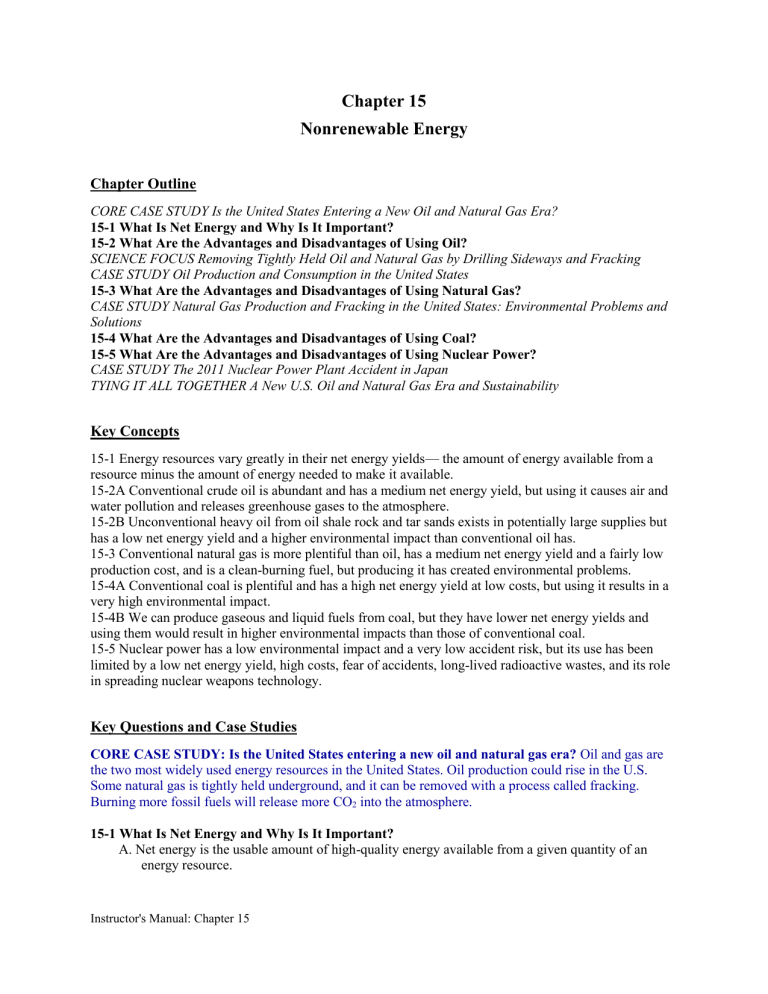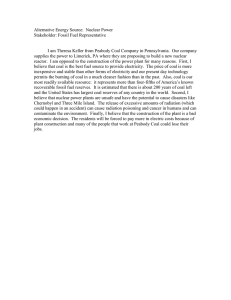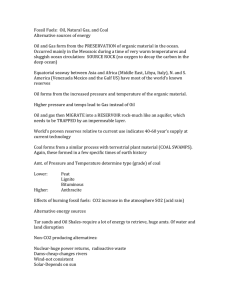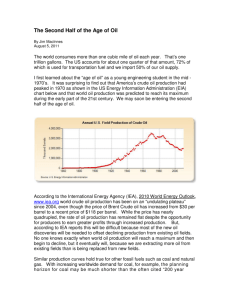
Chapter 15
Nonrenewable Energy
Chapter Outline
CORE CASE STUDY Is the United States Entering a New Oil and Natural Gas Era?
15-1 What Is Net Energy and Why Is It Important?
15-2 What Are the Advantages and Disadvantages of Using Oil?
SCIENCE FOCUS Removing Tightly Held Oil and Natural Gas by Drilling Sideways and Fracking
CASE STUDY Oil Production and Consumption in the United States
15-3 What Are the Advantages and Disadvantages of Using Natural Gas?
CASE STUDY Natural Gas Production and Fracking in the United States: Environmental Problems and
Solutions
15-4 What Are the Advantages and Disadvantages of Using Coal?
15-5 What Are the Advantages and Disadvantages of Using Nuclear Power?
CASE STUDY The 2011 Nuclear Power Plant Accident in Japan
TYING IT ALL TOGETHER A New U.S. Oil and Natural Gas Era and Sustainability
Key Concepts
15-1 Energy resources vary greatly in their net energy yields— the amount of energy available from a resource minus the amount of energy needed to make it available.
15-2A Conventional crude oil is abundant and has a medium net energy yield, but using it causes air and water pollution and releases greenhouse gases to the atmosphere.
15-2B Unconventional heavy oil from oil shale rock and tar sands exists in potentially large supplies but has a low net energy yield and a higher environmental impact than conventional oil has.
15-3 Conventional natural gas is more plentiful than oil, has a medium net energy yield and a fairly low production cost, and is a clean-burning fuel, but producing it has created environmental problems.
15-4A Conventional coal is plentiful and has a high net energy yield at low costs, but using it results in a very high environmental impact.
15-4B We can produce gaseous and liquid fuels from coal, but they have lower net energy yields and using them would result in higher environmental impacts than those of conventional coal.
15-5 Nuclear power has a low environmental impact and a very low accident risk, but its use has been limited by a low net energy yield, high costs, fear of accidents, long-lived radioactive wastes, and its role in spreading nuclear weapons technology.
Key Questions and Case Studies
CORE CASE STUDY: Is the United States entering a new oil and natural gas era?
Oil and gas are the two most widely used energy resources in the United States. Oil production could rise in the U.S.
Some natural gas is tightly held underground, and it can be removed with a process called fracking.
Burning more fossil fuels will release more CO
2
into the atmosphere.
15-1 What Is Net Energy and Why Is It Important?
A.
Net energy is the usable amount of high-quality energy available from a given quantity of an energy resource.
Instructor's Manual: Chapter 15
1.
Currently, oil has a high net energy ratio because it comes from large concentrated deposits.
As these reserves dwindle, the net energy ratio declines.
2.
Any energy source with low or negative net energy yield cannot compete in the marketplace.
15-2 What Are the Advantages and Disadvantages of Using Oil?
A.
Oil supplies 1/3 of the world’s commercial energy and 40% for the US.
B.
Crude oil is a thick liquid containing hydrocarbons.
C.
Peak production occurs when the pressure in a well drops and production starts to decline.
1.
Global peak production is the point at which the world meets maximum production.
D.
After extraction, oil is refined.
E.
Petrochemicals are used as raw materials chemicals, plastics and many other products.
F.
Proven oil reserves are deposits from which oil can be extracted profitably under current conditions.
G. The OPEC countries—most of them in the Middle East—have 2/3 of the world’s proven oil reserves and most of the world’s unproven reserves. Oil is the most widely used resource in the world.
H. The United States produces about 9% of the world’s crude oil and uses about 23% of crude oil extracted worldwide each year.
SCIENCE FOCUS: Removing tightly held oil and natural gas by drilling sideways and fracking . Until recently, extracting tightly held gas and oil was too costly. Two newer extraction technologies exist to remove these kinds of resources. Horizontal drilling is accomplished with a flexible bore to gain greater access to oil and gas deposits. Fracking, or hydraulic fracturing, uses high pressure water, chemicals, and sand to extract the resources.
I. Burning oil produces air pollution and releases the greenhouse gas carbon dioxide into the atmosphere.
CASE STUDY: Oil production and consumption in the United States.
The United States gets about 87% of its commercial energy from fossil fuels. Since 1982, oil consumption in the U.S. has greatly exceeded domestic production. In 2012, the five largest suppliers of oil imported into the
United States were, in order, Canada, Saudi Arabia, Venezuela, Mexico, and Iraq.
J. Oil shales are rocks that are a potential supply of heavy oil
1. 72% of these reserves are in the U.S. states of Colorado, Wyoming and Utah, primarily on public land.
2. It takes considerable energy and money to convert this to shale oil. Net energy is low.
15-3 What Are the Advantages and Disadvantages of Using Natural Gas?
A.
Natural gas consists mostly of methane and is often found above reservoirs of crude oil. Natural gas also contains small amounts of heavier hydrocarbons and a small amount of hydrogen sulfide.
1.
Russia has about 25% of the world’s supply. The United States has about 3.4 %.
2.
Burning natural gas releases less CO
2
per unit of energy than burning oil, oil sand, or coal.
CASE STUDY: Natural gas production and fracking in the United States: environmental problems and solutions . Drinking water can easily be contaminated by the process of hydraulic fracturing. Fracking also requires enormous volumes of water. Fracking fluids contain hazardous chemicals. Producers maintain that fracking is necessary, and that groundwater contamination has not been recorded.
B.
Coal bed methane gas is found in coal beds across parts of the United States and Canada. These resources are now actively used but have large potential impacts on air quality and water quality.
C.
Methane hydrate deposits are another source of unconventional natural gas found in the arctic permafrost and deep beneath the ocean bottom. Extraction techniques are too expensive at present.
Instructor's Manual: Chapter 15
15-4 What Are the Advantages and Disadvantages of Using Coal?
A.
Coal is a solid fossil fuel formed from land plants that lived 300–400 million years ago. It is an abundant energy resource that is burned mostly to produce electricity and steel.
1.
Supplies could last from 214 to 1125 years depending on use.
2.
The United States has 28% of the world’s proven reserves.
3.
Burning coal releases SO
2
and fine particle pollution.
4.
Coal burning plants are among the largest emitters of carbon dioxide.
5.
Burning coal emits trace amounts of mercury and radioactive materials.
6.
The use of coal is growing, especially in China.
B.
Beginning in 2008, the coal industry and related companies began funding a clean coal publicity campaign. Critics argue that there is no such thing as clean coal.
C.
Coal can be converted to gaseous and liquid fuels that burn cleaner than coal, but the costs are high and burning them releases more carbon dioxide than burning coal. Coal can be converted into synthetic natural gas (SNG or syngas) by coal gasification or into liquid fuel by coal liquefaction. These procedures require 50% more coal be mined and will add 50% more CO
2 emissions to the atmosphere.
15-5 What Are the Advantages and Disadvantages of Using Nuclear Energy?
A.
Nuclear power is complex and costly, relying on a controlled nuclear fission reaction that takes place in a reactor. Light water reactors produce 85% of the world’s nuclear generated electricity.
1.
LWRs lose about 75% of energy as waste heat.
2.
The entire fuel cycle has a low to negative net energy yield when accounting for mining and upgrading uranium fuel as well as storing wastes and dismantling old plants.
B.
Proponents of nuclear power tend to focus on low emissions. However, the entire nuclear fuel cycle includes the mining and enrichment of uranium, and the safe storage of wastes.
C.
436 nuclear reactors in 31 countries produce 6% of the world’s commercial energy, and 14% of its electricity.
D.
The government has provided subsidies, tax breaks and loan guarantees to the nuclear power industry.
E.
An obstacle to nuclear power development has been safety concerns. Built-in safety features make the risk of exposure to radioactivity in more developed countries extremely low.
F.
Spent fuel rods are removed and stored outside the reactor in water-filled pools. After years of cooling, they can be transferred to dry casks where they need to be stored safely for thousands of years.
CASE STUDY : The 2011 nuclear power plant accident in Japan . A major accident occurred on
March 11, 2011 at the Fukushima Daiichi Nuclear Power Plant in Japan. The accident was triggered by a major earthquake that caused a severe tsunami. Preliminary studies indicate that four key human-related factors contributed to the accident: failure of the utility company to develop worstcase scenarios; the plant’s seawalls were not built high enough; design flaws exposed the emergency core cooling system controls and backup generators to flooding; and a too-cozy relationship between plant owners and government officials.
G.
There are three ways to retire worn out nuclear power plants.
1.
Dismantle and store the radioactive parts in a secure place.
2.
Install a physical barrier and monitor it securely for 30-100 years.
3.
Entomb the plant in concrete.
H.
Nuclear power may not be able to lessen our dependence on foreign oil, as only 2% of our electricity comes from oil burning plants.
1.
95% of uranium used in U.S. power plants is imported, primarily from Russia.
I.
Nuclear fusion involves nuclear change in which two isotopes of a light element are forced together until they fuse, releasing energy in the process. This technology is still in the laboratory stage.
Instructor's Manual: Chapter 15
Teaching Tips:
Large Lecture Classes:
Poll the class on whether we should open offshore sites and ANWR to drilling. Poll again after covering the oil section and discussing the distribution of oil reserves globally. Discuss any differences in perspectives before and after the presentation of the oil section. Carry out a similar poll for nuclear energy after discussing the positive aspects of nuclear energy and again after the negative aspects.
Smaller Lecture Classes:
Break the class up into teams of four students and ask them to develop a consensus statement about whether or not the U.S. should invest more heavily in nuclear energy and/or oil shale development. In the event that the group cannot agree on a recommendation, ask the group to have a vote and record the results. Have a representative from each group read the statement to the class and report on the vote. Use the results (and conflict) to highlight the difficulty in these particular decisions and discuss the problems in coming to a consensus statement.
Key Terms
coal crude oil liquefied natural gas (LPG) liquefied petroleum gas (LPG) natural gas net energy
Term Paper Research Topics
nuclear fusion oil sand peak production petrochemicals petroleum proven oil reserves shale oil synthetic natural gas (SNG) tar sand unproven reserves
1. Oil and natural gas: oil prices and economic development in developing countries; enhanced oilrecovery techniques; shale oil extraction; petrochemicals; heavy oils from Athabascan tar sands;
Alaska's Prudhoe Bay gas deposits.
2. Coal: low-sulfur coal reserves in the United States; geographic distribution of coal-burning power plants in the United States; fluidized-bed combustion; the U.S. Synthetic Fuels Corporation.
3. Nuclear fission: centralized energy planning in France; genetic damage to A-bomb survivors; Three
Mile Island; Chernobyl; how nuclear fuel assemblies are made; radioactive tailings as a health hazard; geologic repositories for high-level radioactive wastes; commercial low-level nuclear waste dump sites; storing high-level liquid wastes; geographic distribution of nuclear power plants in the
United States; keeping weapons-grade nuclear materials "out of the wrong hands"; nuclear reprocessing plants.
4. Breeder nuclear fission versus conventional nuclear fusion; pros and cons.
5. Nuclear regulation in the U.S.: who should be involved in decision making about the development of nuclear energy?
Instructor's Manual: Chapter 15
6. What are the trade-offs of coal and unconventional fossil fuel development (e.g., oil shales)?
Evaluate these resources from a national security perspective and from an environmental perspective.
How do these differ?
7. Examine the legal and societal implications of the Mining Law of 1872; The Atomic Energy
Commission (1946–1975); the Nuclear Regulatory Commission; the Energy Research and
Development Administration (ERDA); the Nuclear Safety Analysis Center; the Institute of Nuclear
Power Operations; the Price-Anderson Act.
8. What is the relationship between the United States and countries with large supplies of critical and strategic energy sources? What should it be?
9. What is clean coal? Does it offer real promise and should it be developed in the U.S.?
10. Evaluate all U.S. oil reserves and estimate the potential supply in these reserves. Is that supply sufficient to justify extraction?
Discussion Topics
1. U.S. dependence on imported oil.
2. Strategic and environmental implications of oil versus coal distributions globally. Would the world be different if coal was the major fossil fuel used?
3. Fossil fuels and the greenhouse effect. How do you balance use of fossil fuels against the risks of climate change?
4. Environmental versus economic tradeoffs of domestic oil drilling.
5. Oil and gas exploration on public lands. How much development should occur in sensitive ecological settings?
6. What will happen when oil runs out?
7. Should the U.S. mandate higher energy efficiency?
Instructor's Manual: Chapter 15






